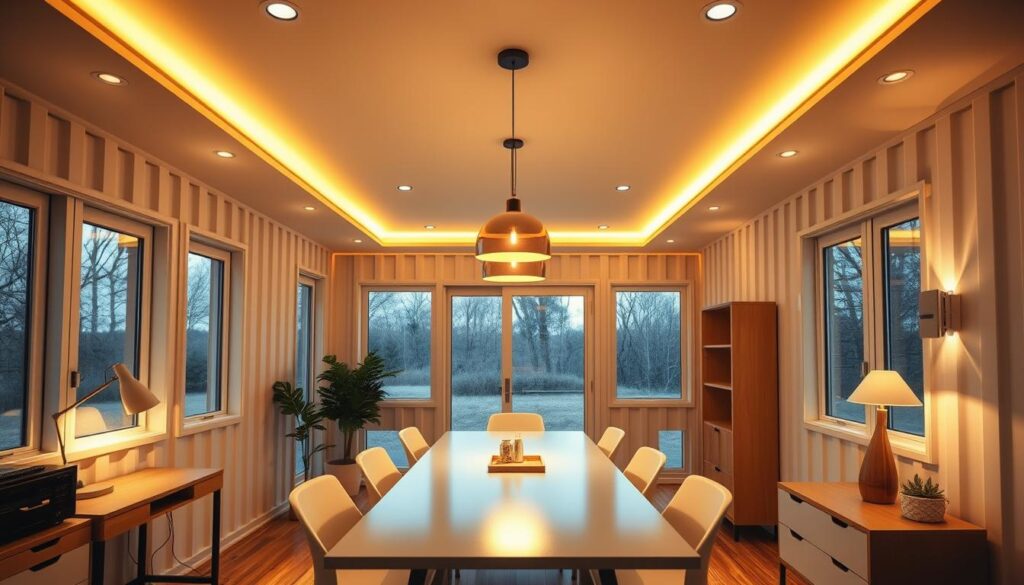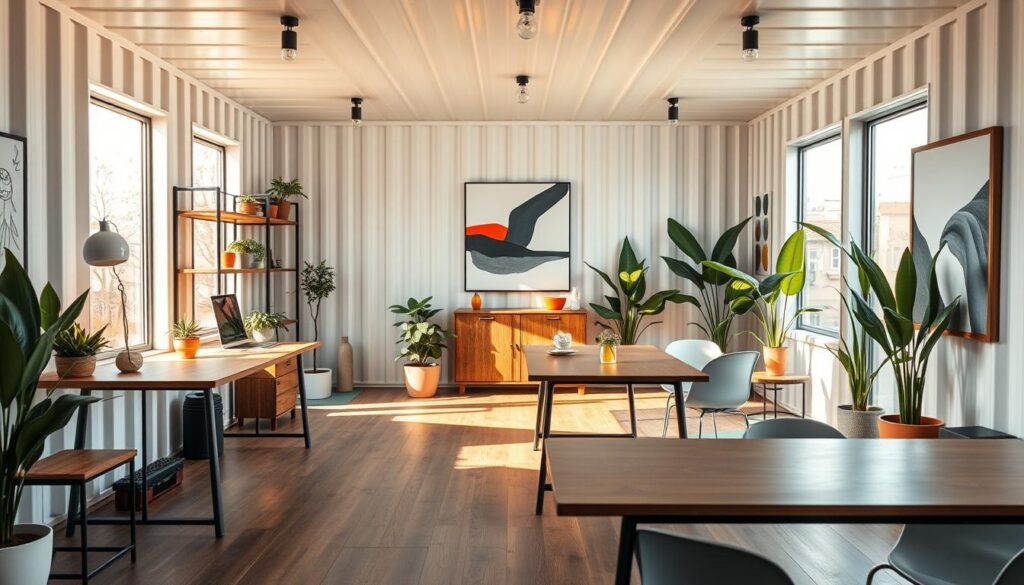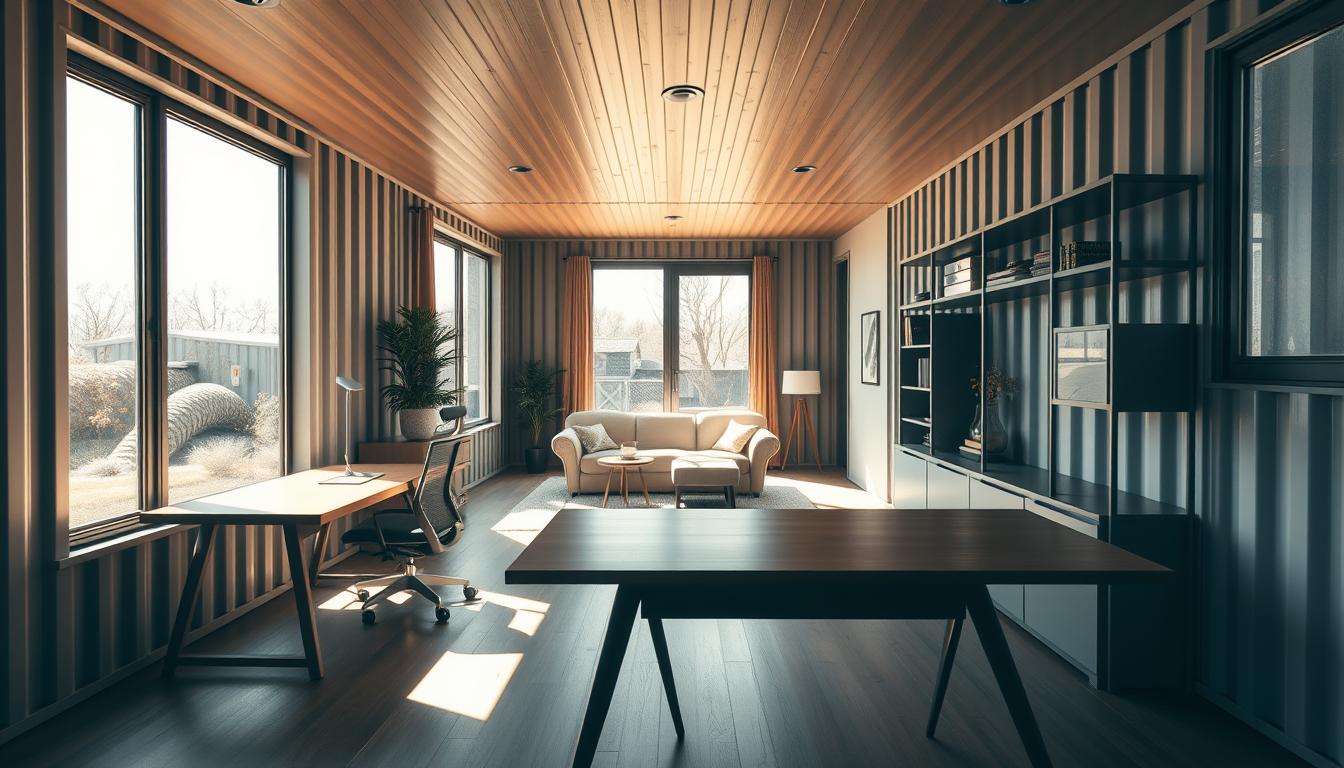With the rise of remote work, having a dedicated and well-designed home office is becoming increasingly important. Shipping containers offer a unique opportunity to create functional and stylish workspaces. According to Cedreo, professionals can create standout designs by transforming 20-foot storage containers into tiny guest houses or private offices.
The adaptability of shipping containers makes them ideal for creative and sustainable projects like home office design. They are durable, modular, and can be converted into offices that are both functional and aesthetically pleasing.
Key Takeaways
- Shipping containers can be repurposed into functional home offices.
- They offer a sustainable and creative solution for workspace design.
- Durability and modularity are key benefits of using shipping containers.
- A well-designed home office can enhance productivity and work experience.
- Container homes provide a unique opportunity for stylish and functional workspaces.
The Rise of Container Home Offices
Shipping containers are increasingly being repurposed as home offices, offering a unique blend of functional design and style. This trend is driven by the need for flexible and adaptable workspaces that can cater to the evolving needs of modern professionals.
Why Shipping Containers Make Excellent Office Spaces
Shipping containers are gaining popularity as home offices due to their inherent advantages. They offer a robust and secure structure that can be easily modified to suit various office needs. Their mobility allows for relocation if necessary, making them an ideal choice for businesses with changing requirements.
Benefits of Separate Work Environments
Having a dedicated workspace, such as a container home office, can significantly enhance productivity. It provides a clear separation between work and personal life, reducing distractions and improving work-life balance. This separation is crucial for maintaining professional focus and achieving a healthier lifestyle.
Growing Popularity in the American Market
The American market is witnessing a surge in the adoption of container home offices, driven by their sustainability and unique design possibilities. As more professionals seek flexible and eco-friendly work solutions, the demand for container offices is expected to continue growing.
Key Considerations Before Starting Your Container Office Project
Creating a functional and stylish office design begins with understanding the essential considerations. When planning to transform a shipping container into a unique office space, several factors come into play.
Space Requirements and Zoning Regulations
Assessing your space needs is crucial. Consider the size of your team, the type of work you’ll be doing, and any specific requirements such as meeting rooms or storage areas. Additionally, familiarize yourself with local zoning regulations to ensure your container office complies with all legal requirements.
Budget Planning and Cost Expectations
Establishing a realistic budget is vital. Costs can include purchasing or renting the container, modifications, insulation, electrical and plumbing installations, and finishing work. For inspiration and ideas on creating a unique office space, exploring existing container office designs can be helpful.
Timeline and Installation Process
Understanding the timeline for your project is essential for planning. This includes the delivery of the container, preparation of the site, installation, and completion of the interior. A well-planned timeline helps in managing expectations and ensuring a smooth transition into your new office.
Hiring Professionals vs. DIY Approaches
Deciding whether to hire professionals or adopt a DIY approach depends on your expertise, budget, and the complexity of your project. While hiring professionals can ensure compliance with regulations and high-quality finishes, a DIY approach can save on labor costs. Weighing the pros and cons of each approach is crucial for making an informed decision.
By carefully considering these factors, you can create a container office that is not only functional but also a unique office space that reflects your style and meets your work requirements.
Container Home Office Design: Function Meets Style
Designing a container home office requires a thoughtful blend of functionality and aesthetics. As the trend of working from home continues to grow, creating a workspace that is both productive and visually appealing becomes increasingly important.
Balancing Practicality with Aesthetics
A well-designed container home office must balance practicality with aesthetics. This involves incorporating elements such as ergonomic furniture and modern technologies to create a comfortable and efficient workspace. For instance, using adjustable desks and chairs can significantly enhance comfort during long working hours.
Moreover, the aesthetic appeal of the office can be enhanced by incorporating natural elements and modern design principles. As noted by interior design experts, “A workspace that is both functional and beautiful can significantly boost productivity and job satisfaction.”
Creating a Cohesive Design Language
Creating a cohesive design language is crucial for a container home office. This involves selecting a consistent color scheme, materials, and design elements that reflect your personal style and work requirements. A cohesive design not only enhances the visual appeal but also contributes to a more focused and productive work environment.
| Design Element | Practical Consideration | Aesthetic Consideration |
|---|---|---|
| Color Scheme | Impact on mood and productivity | Consistency with personal style |
| Furniture | Ergonomic and functional | Modern and visually appealing |
| Lighting | Adequate for tasks | Natural and energy-efficient |
Adapting Design to Your Work Requirements
Adapting the design of your container home office to your specific work requirements is essential. This may involve creating distinct work zones for different tasks or incorporating storage solutions for a clutter-free environment. As your work needs evolve, your office design should be flexible enough to adapt.
By focusing on both functionality and aesthetics, you can create a container home office that is not only a creative workspace but also a reflection of your personal style. Whether you’re working with a new or used container, the design possibilities are vast, allowing you to craft a unique and productive work environment.
Selecting the Right Container for Your Office Needs
The success of your container office project hinges on selecting the right shipping container. This decision is foundational to creating a functional and stylish home office that meets your specific needs.
Standard Container Sizes and Their Applications
Shipping containers come in various sizes, but the most commonly used for offices are 20-foot and 40-foot containers. A 20-foot container is ideal for small businesses or startups, offering about 160 square feet of space. On the other hand, a 40-foot container provides double the space, making it suitable for larger teams or those requiring more room for operations.
New vs. Used Containers: Pros and Cons
When choosing a shipping container, you must decide between new and used containers. New containers offer the advantage of being in pristine condition, with no signs of wear and tear. However, they are more expensive. Used containers, while more budget-friendly, may require repairs or refurbishments.
- Pros of new containers: Minimal maintenance, modern appearance, and full warranty.
- Cons of new containers: Higher cost.
- Pros of used containers: Cost-effective, environmentally friendly.
- Cons of used containers: Potential for needed repairs, possible rust or damage.
Structural Modifications to Consider
Depending on your needs, you may need to make structural modifications to your shipping container. This could include cutting out sections for windows or doors, adding insulation, or reinforcing the structure for specific equipment.
- Assess your needs: Determine what modifications are necessary for your office setup.
- Consult professionals: Ensure that any modifications comply with local building codes and regulations.
- Plan for future needs: Consider potential future modifications or expansions.
Container Condition Assessment Tips
When inspecting a used shipping container, look for signs of damage, rust, or poor condition. Check the roof, walls, floor, and doors for any issues that could affect the integrity or usability of the container.
By carefully selecting the right shipping container and considering necessary modifications, you can create a contemporary work environment that is both functional and aesthetically pleasing.
Optimizing Interior Layout for Productivity
Optimizing the interior of a shipping container home office is crucial for enhancing productivity. A well-planned layout can significantly impact your work efficiency and overall job satisfaction.
Space-Efficient Furniture Arrangements
To maximize space, it’s essential to choose furniture that is both functional and compact. Consider using multi-functional furniture pieces that can serve more than one purpose, such as a desk with built-in storage. Efficient furniture arrangements can help create a clutter-free environment, promoting a more focused work atmosphere.
Storage Solutions for Small Spaces
Effective storage is vital in small container offices. Utilize vertical storage solutions like wall-mounted shelves and cabinets to keep your workspace organized. Additionally, consider incorporating hidden storage compartments to maintain a tidy appearance.
Creating Distinct Work Zones
Dividing your container office into distinct zones can enhance productivity. Create separate areas for work, meetings, and relaxation. This zoning can help you stay organized and reduce distractions. For more insights on innovative office spaces, visit exploring shipping containers as innovative office.
Ergonomic Considerations for Long-Term Comfort
Ergonomic design is crucial for long-term comfort and health. Ensure that your workspace is set up to promote good posture and reduce eye strain. Invest in an ergonomic chair and position your computer monitor at eye level. Proper ergonomics can help prevent work-related injuries and improve overall well-being.
By implementing these strategies, you can create a functional design that enhances your productivity and comfort in your container home office.
Lighting Strategies for Container Offices
Incorporating the right lighting solutions is vital for a functional and stylish home office design. Effective lighting can significantly impact productivity and comfort in a container office.
Natural Light Maximization Techniques
Maximizing natural light is crucial for creating a welcoming workspace. Using large windows and skylights can significantly enhance the natural lighting in your container office. Cedreo suggests that this approach not only reduces the need for artificial lighting but also boosts mood and productivity.
Artificial Lighting for Productivity
While natural light is essential, artificial lighting plays a critical role in maintaining a productive workspace, especially during periods with limited daylight. Using energy-efficient LED lighting can help reduce energy consumption while providing adequate lighting.

Window and Skylight Placement
Strategic placement of windows and skylights is key to maximizing natural light. Consider the orientation of your container office and place windows and skylights accordingly to capture the most natural light throughout the day.
Energy-Efficient Lighting Options
Energy-efficient lighting is not only good for the environment, but it also reduces operational costs. LED lighting and smart lighting systems are excellent options for container offices, offering flexibility and efficiency.
| Lighting Type | Energy Efficiency | Cost-Effectiveness |
|---|---|---|
| LED Lighting | High | Yes |
| Smart Lighting | High | Yes |
| Traditional Lighting | Low | No |
Climate Control and Insulation Solutions
To ensure a container home office remains functional and comfortable throughout the year, effective climate control and insulation are vital. Proper insulation helps maintain a consistent internal temperature, reducing the need for excessive heating or cooling.
Effective Insulation Methods for Metal Structures
For metal container offices, insulation is critical to prevent heat loss in winter and heat gain in summer. Recommended insulation materials include PUR foam and mineral wool, which offer excellent thermal performance and can be installed on walls, floors, and ceilings.
Heating and Cooling Options
Selecting the right heating and cooling systems is essential for maintaining a comfortable working environment. Options include:
- Portable heaters and air conditioners
- Split system air conditioners
- Heat pumps
Each option has its advantages, and the choice depends on the specific climate and insulation of the container office.
Ventilation Considerations
Adequate ventilation is crucial for removing stale air and preventing moisture buildup, which can lead to mold and mildew. Installing vents or a mechanical ventilation system can help maintain good air quality.
Weather-Proofing for Different US Climates
The US experiences a wide range of climates, from humid subtropical to arid desert conditions. Weather-proofing strategies should be tailored to the local climate, including sealing gaps, using weather-resistant materials, and ensuring that insulation is appropriate for the local temperature fluctuations.
By addressing climate control and insulation effectively, container home offices can provide a comfortable and productive workspace regardless of the external weather conditions.
Stylish Interior Design Elements for Container Offices
Creating a unique office space within a container involves balancing functionality with aesthetic appeal. A well-designed container office not only enhances productivity but also provides a comfortable and inspiring work environment.
Color Schemes That Enhance Productivity
The choice of color scheme is crucial in setting the tone for your container office. Different colors can influence mood, energy, and focus. For instance, blue tones are known to promote calmness and concentration, while yellow can boost creativity and optimism.
When selecting a color scheme, consider the type of work you’ll be doing and the ambiance you wish to create. A harmonious palette can make your workspace feel more welcoming and stimulating.
Material Selection for Warmth and Comfort
The materials used in your container office can significantly impact its comfort and aesthetic appeal. Incorporating natural materials like wood and stone can add warmth and texture to the space. Additionally, using comfortable and ergonomic furniture can enhance the overall working experience.
Incorporating Personal Style Elements
Personalizing your container office with elements that reflect your style or brand identity can make the space feel more inviting. This could include artwork, plants, or unique decorative pieces that inspire creativity and motivation.
Design Trends for Container Workspaces
Staying abreast of current design trends can help keep your container office modern and fresh. Some popular trends include incorporating sustainable materials, using flexible workspaces, and integrating technology seamlessly into the design.
| Design Element | Description | Benefit |
|---|---|---|
| Color Scheme | Selection of colors that influence mood and productivity | Enhances focus and creativity |
| Natural Materials | Incorporation of wood, stone, and other natural elements | Adds warmth and comfort |
| Personal Touches | Artwork, plants, and unique decorative pieces | Creates a personalized and inspiring workspace |

Exterior Finishing and Landscaping Integration
The exterior of your shipping container office is just as important as the interior, playing a crucial role in creating a contemporary work environment. A well-designed exterior not only enhances the aesthetic appeal but also contributes to the overall functionality of the space.
Exterior Cladding and Finishing Options
Exterior cladding and finishing options can significantly improve the appearance and durability of your container office. Materials such as wood, metal, and vinyl can be used to create a unique and inviting exterior. For instance, adding a wooden façade can give your container office a warm, natural look that blends with its surroundings.
Connecting Your Office to Outdoor Spaces
Integrating your container office with outdoor spaces can enhance its appeal. This can be achieved by adding decks, patios, or gardens around the office. Creating a seamless transition between indoors and outdoors can boost productivity and well-being.
Creating a Professional Entrance
A professional entrance is crucial for making a good impression. This can be achieved by designing an inviting doorway, adding signage, and incorporating landscaping elements around the entrance. A well-designed entrance not only adds to the aesthetic appeal but also sets the tone for the workspace inside.
Sustainable Landscaping Around Your Container Office
Sustainable landscaping practices can reduce the environmental impact of your container office. Using native plants, implementing rainwater harvesting systems, and minimizing water consumption are effective strategies. Sustainable landscaping not only benefits the environment but also creates a healthier workspace.
Sustainability and Eco-Friendly Features
The repurposing of shipping containers into home offices is a testament to innovative sustainable design. By giving new life to existing materials, container home offices significantly reduce the need for new raw materials and the waste associated with traditional construction methods.
Environmental Benefits of Container Repurposing
Reusing shipping containers for home offices reduces the environmental impact in several ways. Firstly, it decreases the demand for new building materials, thereby conserving natural resources. Secondly, it minimizes the waste that would otherwise end up in landfills. As Emily Jones, a sustainable design expert, notes, “Repurposing containers is a creative way to reduce, reuse, and recycle, embodying the principles of sustainable living.”
Solar Power and Renewable Energy Options
Container home offices can be easily integrated with renewable energy sources, such as solar power. Installing solar panels on the roof or nearby can provide a clean and sustainable source of energy. This not only reduces reliance on fossil fuels but also lowers energy costs in the long run.
Water Conservation Strategies
Implementing water conservation strategies is another crucial aspect of making container home offices more sustainable. This can be achieved through the installation of low-flow fixtures and rainwater harvesting systems. Such measures significantly reduce water consumption, contributing to a more eco-friendly home office design.
Sustainable Materials for Interior Finishing
The choice of materials for interior finishing plays a vital role in maintaining the eco-friendly nature of container home offices. Using sustainable materials such as reclaimed wood, bamboo, and low-VOC paints can enhance the indoor air quality and reduce the environmental footprint. As the trend towards sustainable living continues to grow, incorporating these materials into home office design becomes increasingly important.
By embracing these sustainable practices, container home office designs not only contribute to a healthier environment but also create a unique and functional workspace that reflects the values of eco-conscious individuals.
Conclusion: Creating Your Ideal Container Home Office
By considering the various aspects discussed in this article, individuals can create a container home office that is both functional and stylish. A well-designed container office can enhance productivity and provide a comfortable workspace.
To achieve a functional design, it’s essential to balance practicality with aesthetics, creating a cohesive design language that adapts to your work requirements. Cedreo’s tools and resources can aid in the design process, helping to bring the vision of a perfect container office to life with a stylish office design.
With careful planning and consideration of factors such as space requirements, zoning regulations, and climate control, you can create a unique and efficient workspace that meets your needs. By incorporating sustainable features and eco-friendly elements, you can also reduce your environmental footprint.

